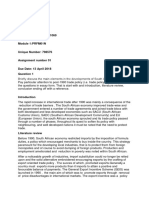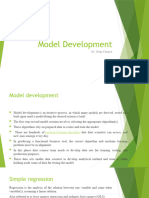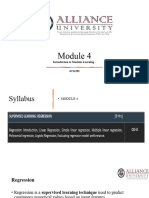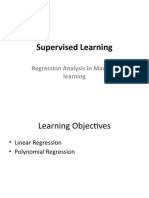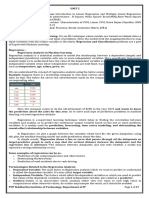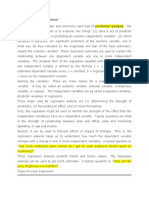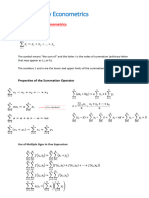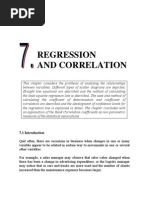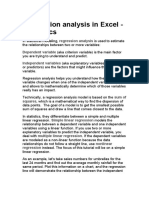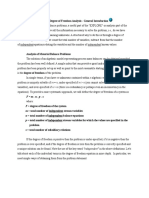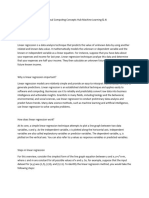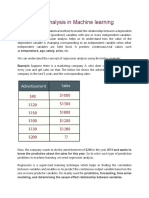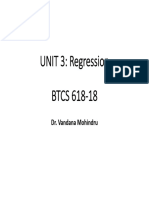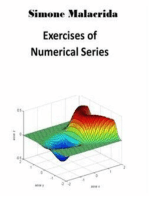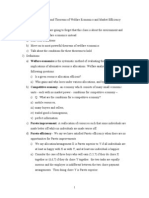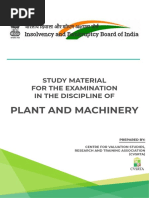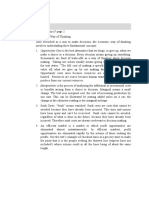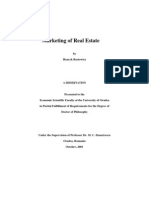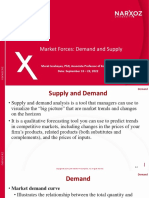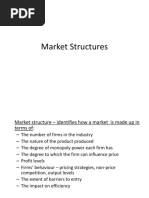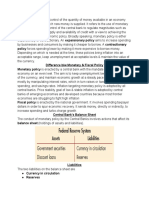Handout-Comparative Static Analysis
Handout-Comparative Static Analysis
Uploaded by
vincentljzCopyright:
Available Formats
Handout-Comparative Static Analysis
Handout-Comparative Static Analysis
Uploaded by
vincentljzOriginal Description:
Copyright
Available Formats
Share this document
Did you find this document useful?
Is this content inappropriate?
Copyright:
Available Formats
Handout-Comparative Static Analysis
Handout-Comparative Static Analysis
Uploaded by
vincentljzCopyright:
Available Formats
Appen dix B: Comp a r a tiv e Static Analysis
Comparative Static Analysis An economic system can be modeled by using a system of equations. Comparative static analysis is a tool that can be used to analyze a system of equations. The use of comparative static analysis on an economic model can provide valuable information about how an economic system works. 1 Modeling a System A general approach for considering a system is diagrammed in Figure B. below. There are inputs to the system and outputs from the system. The system itself can be thought of as machine that transforms inputs into outputs. !hen the inputs and outputs of a system can be quantified" variables can be assigned to each input and output. #sing variables to represent the levels of the inputs and outputs is useful because the levels tend to change over time. An endogenous variable is an output variable of the system. The level of each endogenous variable is determined by the system. An exogenous variable is an input variable to the system. The level of an e$ogenous variable is not determined by the system" but rather is determined outside the system. Figure 1: Modeling a System
Endogenous Variable Exogenous Variable
Inputs Exo g e n o us Va ria b le s
The system itself is represented by a system of equations. %ach equation captures a relationship that is thought to e$ist between the endogenous and e$ogenous variables. A basic rule of thumb is that the number of endogenous variables that can be determined by a system is equal to the number of independent equations in the system. For e$ample" if you desire to e$plain the behavior of & economic variables" then you must construct a model with & independent equations. !hen e$amining models constructed by others" it is not always obvious which variables are endogenous and which variables are e$ogenous. Typically" the model builder has in mind what variable is 'being endogenized( each time an equation is added to a model. To be clear in presenting your model" it is good to e$plicitly state which variables are endogenous and which are e$ogenous. 2 Comparative Statics A solution to a system of equations is a set of values for the endogenous variables such that all of the equations of the system are simultaneously satisfied. Considering Figure " it is evident that the solution values for the endogenous variables will change if the e$ogenous variables change. A comparative static analysis e$amines how the solution values for the endogenous variables" or output variables" of a system change when the e$ogenous variables" or input variables" change. A ma)or difficulty in analyzing a complicated system is identifying cause and effect. !ith many endogenous and e$ogenous variables changing simultaneously" it is difficult to uncover how a change in a single input variable affects the outputs of the system. For this reason" it is standard
Syst e m Sys t e m of Eq u a t io n s
Outpu t s En d o g e n o us Va ria b le s
System
Solution Comparative Static Analysis
1 -
Appen dix B: Comp a r a tiv e Static Analysis
practice when performing comparative static analyses to e$amine the changes in the solutions for the endogenous variables that occur when one e$ogenous variable is increased by one unit. A comparative static multiplier gives the change in a chosen endogenous variable when a chosen e$ogenous variable increases by one unit. Thus" if there are & endogenous variables and * e$ogenous variables in a model" then +&,+*, - .& comparative static multipliers can be calculated. /n this book" the comparative static multiplier for an endogenous variable y given a one unit increase in an e$ogenous variable x is written y0x" mathematically recognizing that the multiplier is the partial derivative of the endogenous variable take with respect to the e$ogenous variable. !hen the system of equations being analyzed can be solved" the following five step approach can used to perform a comparative static analysis1 . !rite down the model as a system of equations. 2. Classify the variables in model. /dentify the endogenous variables in model. The number of endogenous variables should be equal to the number of independent +or nonequivalent, equations in the model. Classify the remaining variables as e$ogenous variables. .. 3olve the model1 Find the solution for each endogenous variable as a function of the model4s e$ogenous variables. 5. Calculate the comparative static multipliers. Choose an endogenous variable of interest. Choose an e$ogenous variable of interest. Take the derivative of the solution for the endogenous variable with respect to the e$ogenous variable of interest. #se different endogenous and e$ogenous variable combinations until all the desired comparative static multipliers have been found. &. /nterpret each comparative static multiplier calculated as the change in the endogenous variable of interest that occurs when the e$ogenous variable of interest increases by one unit. Those who are not very familiar with calculus may find the mathematics of comparative static analysis overwhelming. For those in this situation" the preferable course of action would be to learn the mathematics since some results can only be obtained using the mathematics. +A good first step would be to carefully study the mathematical appendi$ of this book., 6owever" many comparative static results can be obtained using graphical tools. Thus" even those who cannot calculate derivatives can do comparative static analyses. The e$ample in the ne$t section will help make the general ideas discussed in this section and the last section more concrete. 3 An Example: A Mar et !or a "roduct 3uppose you want to develop a model of a market for a product. !e do not have to specify the product. !e need only know that the market is for an output of a production process +i.e." a good or service, as opposed to an input +e.g." labor,. A market always involves an interaction between buyers and sellers. A model of a market for a specific product can be developed using a system of equations as follows. First" develop an equation to describe the behavior of buyers. 3econd" develop an equation to describe the behavior of sellers. Finally" develop an equation to describe the interaction of buyers and sellers.
Comparative Static Multiplier
Appen dix B: Comp a r a tiv e Static Analysis
Although many factors may affect the willingness of buyers to buy a product" let4s only consider two here1 price and income. 7et the variable 8 denote the demand for the product +i.e." the amount of the product which buyers wish to buy,9 let : denote the price of the product9 and let ; denote the income of buyers. Typically" an increase in price leads to a decrease in demand" while an increase in income leads to an increase in demand. These assumptions are captured by the following linear equation1
D = aY bP " a > < " b > < .
The variables a and b are called sensitivity parameters. The variable a measures the sensitivity of demand to a change in income" while the variable b measures the sensitivity of demand to a change in price. To understand why these variables measure sensitivity" substitute in numbers for the variables ;" :" a" and b. 7et ; - <<" : - ." a - .&" and b - 2. =iven these numbers" 8 - +.&, + <<, > +2,+., - 55. ?ow" note that if ; increases by +from << to < , then 8 increases by a - . & +from 55 to 55.&," while if : increases by +from . to 5, then 8 decreases by b - 2 +from 55 to 52,. This e$ample illustrates that the parameter a gives the change in demand that occurs when income increases by one unit" while the parameter b gives the change in demand that occurs when the product price increases by one unit. /f the sensitivity parameter a were equal to zero" then demand would be totally insensitive to a change in income. /f the sensitivity parameter b were equal to zero" then demand would be totally insensitive to a change in price. As the sensitivity parameter a gets larger" demand becomes more responsive to a change in income. As the sensitivity parameter b gets larger" demand becomes more responsive to a change in price. The demand curve is graphed in Figure 2" with : being treated as the independent variable and 8 being treated as the dependent variable. The demand curve is linear. The intercept of the demand curve is equal to a; and is found by setting independent variable : equal to zero. The slope of the demand curve is >b" equal to the coefficient on the independent variable :. Figure 2: #$e %emand Curve
Sensitivity "arameter
D
aY
3lope = b E&uilibrium Condition
D = aY bP
P
Considering the willingness of sellers to produce and sell a product" assume that only the product price is important. 7et the variable 3 denote the supply of the product +i.e." the amount of the product which sellers wish to sell," and let : denote the price of the product as before. Typically" an increase in price leads to an increase in supply. This assumption is captured by the equation1
S = cP " c > < .
The supply curve is graphed in Figure ." with : being treated as the independent variable and 3 being treated as the dependent variable. The supply curve is linear. The intercept of the supply
3 -
Appen dix B: Comp a r a tiv e Static Analysis
curve is equal to zero" found by setting independent variable : equal to zero. The slope of the supply curve is c" equal to the coefficient on the independent variable :. The variable c is a sensitivity parameter" giving the change in supply that occurs when the price increases by one unit. Figure 3: #$e Supply Curve
S S = cP
3lope = c
E&uilibrium "rice
P
The market is represented in Figure B.5" where the supply and demand curves are each plotted in the same space. The supply and demand curves are each plotted with the price variable : as the independent variable. %$amining the figure" note that supply e$ceeds demand when the price is above the price P@" meaning there is a surplus of the product. Alternatively" demand e$ceeds supply when the price is below the price P@" meaning there is a shortage of the product. /f there was a surplus" we might e$pect the price to decrease. Alternatively" if there was a shortage" we might e$pect the price to increase. Consequently" we would e$pect the price to gravitate toward the price P@ where supply equals demand. This notion can be captured by our model by adding the equilibrium condition S = D.
Figure ': #$e Mar et
S" D
aY
S = cP
P
S @ = D@
D = aY bP
P@
Appen dix B: Comp a r a tiv e Static Analysis
%$amining Figure 5" notice that the equilibrium condition" together with demand equation and supply equation" determines the price P. That is" there is only one price such that supply equals demand>>>the equilibrium price P@. Thus" P is an endogenous variable. As shown on the vertical a$is in Figure 2.5" the equilibrium quantity supplied S@ and the equilibrium quantity demanded D@ are also determined by the three equations of the model. Thus" the variables S and D are also endogenous variables. To summarize" the model consists of the three equations that determine the three endogenous variables S" D" and P. The remaining variables ;" a" b" and c are e$ogenous. The following presentation of the model is useful in that it is brief and complete once the definitions of the variables are understood1 +B. , D = aY bP " a > < " b > < 9 +B.2, S = cP " c > < 9 +B.., S = D . Classification of Aariables +*,1 P, S, D, Y, a" b" c %ndogenous Aariables +.,1 P, S, D %$ogenous Aariables +5,1 a" b" c" ;. To solve the model" remember that the goal is to isolate each endogenous variable on one side of an equation and have only e$ogenous variables on the other side. The abbreviations 3T" AT" and BT used in the solutions below stand for the substitution theorem" the addition theorem" and the multiplication theorem. These theorems are e$plained in Appendi$ A>>>the mathematical appendi$. The mathematical appendi$ also contains an e$ample of how to apply these theorems to solve a system of equations. /t is generally easiest to solve models representing markets by starting with the equilibrium condition. /n this case" by starting with the equilibrium condition" the solution for P can be found1
Cb + cD P = aY "
P=
S=D cP = aY bP " bP + cP = aY "
a Y" b+c
=iven +B.., 3T" +B. ," +B.., AT 8istributive 7aw BT
?otice that the solution for P was found by applying the substitution theorem first" the addition theorem second" and the multiplication theorem last. Those who have had some practice solving systems of equations know that it is quite possible to 'go around in circles( and never reach a solution. As a general rule" applying the theorems in the order used here is best in terms of making progress toward a solution. 6aving found the solution for :" the solutions for 8 can now be found by substitution as follows1
D = aY bP "
=iven + , 3T" 3olution for : Bultiply a; term by
b+c = . b+c
a D = aY b Y" b+c b+c a D=a Y b Y" b+c b+c
5 -
Appen dix B: Comp a r a tiv e Static Analysis
D= ac Y b+c
Combine terms
The solution for 3 can then be easily found1
S = D"
S=
=iven +., 3T" 3olution for 8
ac Y b+c
The solution for : is associated with P@ on the horizontal a$is of Figure B.5. /t is the only price that satisfies equations +B. ," +B.2," and +B.., simultaneously. The solutions for 3 and 8 are associated with 3@ and 8@ on the vertical a$is of Figure B.5. Again" only these solutions are consistent with equations +B. ," +B.2," and +B.., holding simultaneously. The solution is the modelEs predicted value of the endogenous variable. Thus" this model can predict the product price and the quantity of product bought and sold. ?ote" however" that each solution depends upon the e$ogenous variables of the model. Aalues for the e$ogenous variables must be given before the model can generate the predictions for the endogenous variables. /f" for e$ample" it was known that a - .&" b - ." c - 2" and Y - <<" then we can obtain our model4s predictions for the variables P" S" and D from the solutions above1
P= a .& Y= << = < b+c .+ 2
and
S=D=
ac +.&,+ 2 , Y= << = 2< . b+c .+ 2
Thus" given these particular values for the parameters a" b" and c" 2< units would be bought and sold at a price of < +dollars, per unit. 6owever" if the e$ogenous variables change" then the predicted values of the endogenous variables will change. The comparative static multiplier :0; shows the effect that the e$ogenous variable Y has on the endogenous variable P through the system. This multiplier can be calculated as follows1
P a = Y " Y Y b + c a = [ Y] " b + c Y
= a . b +c
3T" 3olution for : Constant Coefficient Fule :ower Fule
The result P 0 Y = a 0 Cb + cD indicates that a one unit increase in Y leads to an increase in P of a0Cb+cD. /f a - .&" b - ." and c - 2" the result would indicate that a one dollar increase in income would lead to increase in the product4s price of a0CbGcD - .&0C.G2D - . <" or < cents.
See the mat h e m a t i c a l app e n di x- --Appe n dix A---for an expl a n a ti o n of how to calculat e com p a r a t iv e static multipliers using the rules of differe n ti a tio n.
1
Appen dix B: Comp a r a tiv e Static Analysis
To show this comparative static result graphically" note that when ; increases the intercept of the demand curve in Figure 5 increases. Thus" as is shown in Figure &" an increase in Y makes the demand curve shift upward. As Y increases from Y to Y2" the equilibrium price level increases from P to P2. ?otice in the figure that the equilibrium quantity bought and sold also increases. The reader should be able to confirm this by showing that the comparative static multipliers D 0 Y and S 0 Y are positive. Figure (: #$e E!!ect o! an increase in )
S" D
aY2
P aY PD2 S2 =
S =D
S = cP
D = aY2 bP D = aY bP P P 2
The comparative static multiplier P 0 c shows the effect that the e$ogenous variable c has on the endogenous variable : through the system. This multiplier can be calculated as follows1
P a = Y " c c b + c = aY " c b + c = aY b + c] " [ c
3T" 3olution for : Constant Coefficient Fule Algebra :ower Fule Algebra
= aY [
[ b + c] 2
aY
][ b + c] 2 "
< <.
The result P 0 c = aY 0 Cb + cD2 indicates that a one unit increase in c leads to a decrease in : of aY 0 Cb + cD2 . To show this comparative static result graphically" note that when c increases the slope of the supply curve in figure 2.5 increases. Thus" as is shown in Figure H" an increase in c makes the supply curve rotate upward. As c increases from c to c2" the equilibrium price level decreases from : to :2. ?otice in the figure that the equilibrium quantity bought and sold increases. The reader should be able to confirm this by showing that the comparative static multipliers D 0 c and S 0 c are positive. Figure *: #$e E!!ect o! an increase in c
S" D
S = c2 P
7 -
Appen dix B: Comp a r a tiv e Static Analysis
S =c P
S 2 = D2
S =D
D = aY bP
P 2
A total of 2 comparative static multipliers can be calculated. For practice" the reader might calculate and interpret these results. /n addition" the reader should be able to show each of the comparative static results diagrammatically. +ey ,ords: Appendix %ndogenous Aariable 3ystem Comparative 3tatic Analysis 3ensitivity :arameter %quilibrium :rice +ey Concepts: Appendix Bodeling an economic system using a system of equations. :erforming a comparative static analysis. %$ogenous Aariable 3olution Comparative 3tatic Bultiplier %quilibrium Condition
.evie/ 0uestions: Appendix . The following equations can be used to represent a model of a 'capital market.( 3olve this system of equations" assuming the endogenous variables are A8" C" /" A3" 3" ;. + , +2, +., +5, +&, +H,
C = C + cY " C > < " I = I bi " I > < " i
AD = C + I
Y = C+ S
AS = A
<< c< > <" b > <
A = AD
2. The following equations can be used to represent a model of a 'money market.( 3olve this system of equations" assuming the endogenous variables are Bd" Bs" and i! + , $ d 0 P = #Y "i " +2, $ s = $ " +., $ d = $ s .
# > <"
$ ><
" > <" Y > <9
.. For the capital market model presented in question " plot consumption C as it depends upon output ; +equation 2," and graph investment / as it depends upon the real interest rate level I +equation .,. /dentify the intercept and slope for each curve you draw. =ive an economic interpretation of the intercept and slope for each curve you have drawn.
Appen dix B: Comp a r a tiv e Static Analysis
5. Find and give economic interpretations of the multipliers Y 0 C and C 0 c for the capital market model presented in question . &. Find and give economic interpretations of the multipliers i 0 $ and i 0 " for the money market model presented in question . H. Assuming C > < " < < c < " > < " i > < " and % > < " plot the following equations in a single C = C + c[Y % ] " +Y,C, coordinate plane1 C =C " C = C + cY " C = C + c[Y % ] i.
9 -
You might also like
- Case Using Demand and Supply AnalysisDocument6 pagesCase Using Demand and Supply AnalysisGiannis Galanakis70% (10)
- ASSIGNMENTDocument7 pagesASSIGNMENTlord0% (1)
- Chapter 4: The Market Forces of Supply and Dem... : What Is A Market?Document5 pagesChapter 4: The Market Forces of Supply and Dem... : What Is A Market?Savannah Simone PetrachenkoNo ratings yet
- Basic Economics of Food MarketDocument29 pagesBasic Economics of Food MarketiloverentNo ratings yet
- Regression Analysis 2Document7 pagesRegression Analysis 2Md Raihan AliNo ratings yet
- Model DevelopmentDocument80 pagesModel Developmentniti guptaNo ratings yet
- Chapter 3&4 Lecture NotesDocument15 pagesChapter 3&4 Lecture NotesAshley ShepherdNo ratings yet
- The Line of Best Fit: Lesson 19.2Document34 pagesThe Line of Best Fit: Lesson 19.2Tin CabosNo ratings yet
- Everything You Need To Know About Linear RegressionDocument19 pagesEverything You Need To Know About Linear RegressionRohit Umbare100% (1)
- Everything You Need To Know About Linear RegressionDocument19 pagesEverything You Need To Know About Linear RegressiondbsgloballoNo ratings yet
- Regression Analysis Linear and Multiple RegressionDocument6 pagesRegression Analysis Linear and Multiple RegressionPauline Kay Sunglao GayaNo ratings yet
- Regression Analysis Linear and Multiple RegressionDocument6 pagesRegression Analysis Linear and Multiple RegressionPauline Kay Sunglao GayaNo ratings yet
- Regression Analysis Linear and Multiple RegressionDocument6 pagesRegression Analysis Linear and Multiple RegressionPauline Kay Sunglao GayaNo ratings yet
- Multiple Regression AnalysisDocument14 pagesMultiple Regression AnalysisDhara KanungoNo ratings yet
- Topic Linear RegressionDocument9 pagesTopic Linear RegressionZuera OpeqNo ratings yet
- MLT Unit 2Document53 pagesMLT Unit 2Ashish MishraNo ratings yet
- Tools of EconomicDocument6 pagesTools of Economicmehaik patwa , 20No ratings yet
- 5 - Pca & Garett RankDocument14 pages5 - Pca & Garett RankWilliam Veloz DiazNo ratings yet
- Ch08 Linear Programming SolutionsDocument26 pagesCh08 Linear Programming SolutionsVikram SanthanamNo ratings yet
- Module 4Document41 pagesModule 4beebeefathimabagum435No ratings yet
- Regression Analysis SPSS Natasha LatifDocument7 pagesRegression Analysis SPSS Natasha Latiflatif_996872197100% (1)
- Linear Regression Analysis in Excel AssingmentDocument17 pagesLinear Regression Analysis in Excel AssingmentVijay MNo ratings yet
- L4a - Supervised LearningDocument25 pagesL4a - Supervised LearningKinya KageniNo ratings yet
- Math (Regression Theory)Document31 pagesMath (Regression Theory)Alina BorysenkoNo ratings yet
- Forecasting MethodsDocument44 pagesForecasting MethodsHamis MohamedNo ratings yet
- Consumer UtilityDocument10 pagesConsumer UtilityMichele WillisNo ratings yet
- Regression Analysis in RDocument7 pagesRegression Analysis in RMayank RawatNo ratings yet
- 3 Unit - DspuDocument23 pages3 Unit - Dspusuryashiva422No ratings yet
- Linear RegressionDocument24 pagesLinear Regression1138 Anuj BhowmickNo ratings yet
- ML Unit 2Document27 pagesML Unit 2mehtasandeep2019No ratings yet
- Models AssignmentDocument43 pagesModels Assignmentsamiyeermi219No ratings yet
- Lecture 4 Linear Regression 1 07032024 082032pmDocument32 pagesLecture 4 Linear Regression 1 07032024 082032pmAbdul Mueed ParachaNo ratings yet
- What Is Linear RegressionDocument14 pagesWhat Is Linear RegressionAvanijaNo ratings yet
- Linear Regression Analysis in ExcelDocument15 pagesLinear Regression Analysis in ExcelBertrand SomlareNo ratings yet
- Machine Learning QBDocument32 pagesMachine Learning QBPinjari Soyab ShakilNo ratings yet
- SampleDocument11 pagesSampleGodson OnophurhiNo ratings yet
- EconometricsDocument18 pagesEconometrics迪哎No ratings yet
- UNIt-3 TYDocument67 pagesUNIt-3 TYPrathmesh Mane DeshmukhNo ratings yet
- RegressionDocument48 pagesRegressionIoana CorinaNo ratings yet
- Simple Linear Regression Homework SolutionsDocument6 pagesSimple Linear Regression Homework Solutionscjbd7431100% (1)
- IDS UNIT 5 Linear RegressionDocument27 pagesIDS UNIT 5 Linear RegressionAvyuktha RajuNo ratings yet
- Regression Analysis in ExcelDocument20 pagesRegression Analysis in Excelsherryl caoNo ratings yet
- Unit 2 Notes - FinalDocument32 pagesUnit 2 Notes - FinalAviral GuptaNo ratings yet
- Chapter 2 - Regression AnalysisDocument49 pagesChapter 2 - Regression AnalysisMeron ZebeneNo ratings yet
- MLP Project My Part VPDocument3 pagesMLP Project My Part VPTangirala AshwiniNo ratings yet
- DA2Document12 pagesDA2puneet mishraNo ratings yet
- 6 Regression AnalysisDocument12 pages6 Regression Analysisceyikep910No ratings yet
- Aih Exp 1Document6 pagesAih Exp 1sanket.pingale2004No ratings yet
- Machine Learning: Bilal KhanDocument20 pagesMachine Learning: Bilal KhanOsama Inayat100% (2)
- Degree of Freedom AnalysisDocument7 pagesDegree of Freedom AnalysisFirdaus SeptiawanNo ratings yet
- C291 2019 Lectures 20 21Document12 pagesC291 2019 Lectures 20 21Manan ShahNo ratings yet
- UNIT - IIIDocument9 pagesUNIT - IIImadhurcb1No ratings yet
- Linear Regression. ComDocument13 pagesLinear Regression. ComHamida patinoNo ratings yet
- unit-3 part 2 DADocument20 pagesunit-3 part 2 DANEMANI SRINITYA NEMANI SRINITYANo ratings yet
- Regression Analysis in Machine LearningDocument26 pagesRegression Analysis in Machine Learningvepowo LandryNo ratings yet
- Sales and AdvertisingDocument14 pagesSales and AdvertisingShaheen ZafarNo ratings yet
- Unit - 3 Machine LearningDocument30 pagesUnit - 3 Machine LearningAbhishekNo ratings yet
- Report Lab02Document12 pagesReport Lab02sarveshayaam2023No ratings yet
- Final Answer BankDocument10 pagesFinal Answer BankShumaila KhanNo ratings yet
- Project 2: Submitted By: Sumit Sinha Program & Group: Pgpbabionline May19 - ADocument17 pagesProject 2: Submitted By: Sumit Sinha Program & Group: Pgpbabionline May19 - Asumit sinhaNo ratings yet
- Regression Analysis Summary NotesDocument6 pagesRegression Analysis Summary NotesAbir AllouchNo ratings yet
- Stata TutorialDocument44 pagesStata TutorialFrederico LuisNo ratings yet
- Stata TutorialDocument44 pagesStata TutorialFrederico LuisNo ratings yet
- Fundamental Theorem of Welfare EconomicsDocument8 pagesFundamental Theorem of Welfare EconomicsvincentljzNo ratings yet
- Fundamental Theorem of Welfare EconomicsDocument8 pagesFundamental Theorem of Welfare EconomicsvincentljzNo ratings yet
- Seminar 2Document5 pagesSeminar 2Dan CeresauNo ratings yet
- Dembidollo Exit ExamsDocument143 pagesDembidollo Exit Examsbiruk habtamuNo ratings yet
- I. Module 3: Market Study: Study of Demand Study of Supply Demand-Supply Analysis Study of The Price Marketing ProgramDocument14 pagesI. Module 3: Market Study: Study of Demand Study of Supply Demand-Supply Analysis Study of The Price Marketing ProgramVerna Mae S. CarinNo ratings yet
- Principles of Microeconomics 1 (9301)Document16 pagesPrinciples of Microeconomics 1 (9301)Hucna YousafxaiNo ratings yet
- CVSRTA-Plant and Machinery PDFDocument1,951 pagesCVSRTA-Plant and Machinery PDFMANISH SINGHNo ratings yet
- Sample Questions - Quiz BeeDocument17 pagesSample Questions - Quiz BeeYumi GushikenNo ratings yet
- Set One Principle of Economics - CH 1, 3 and 4Document14 pagesSet One Principle of Economics - CH 1, 3 and 4MaggiehoushaimiNo ratings yet
- Champernowne IS-LMDocument17 pagesChampernowne IS-LMeddieNo ratings yet
- Chapter 3Document19 pagesChapter 3Andika SaputraNo ratings yet
- AndreW LoDocument34 pagesAndreW LoJulio Cesar Juica CcapaNo ratings yet
- 2bromley (Hypothesis About Land Property Rights)Document5 pages2bromley (Hypothesis About Land Property Rights)ramador09No ratings yet
- Ch03 Parkin Demand SupplyDocument61 pagesCh03 Parkin Demand Supply彭斌豪No ratings yet
- Economics Health CareDocument79 pagesEconomics Health CareLuiz CarvalhoNo ratings yet
- Demand Forecasting Written Report PDFDocument35 pagesDemand Forecasting Written Report PDFSheridanne GiloNo ratings yet
- Ugba 101B - Exam - 3 Answers - Spring 2013Document12 pagesUgba 101B - Exam - 3 Answers - Spring 2013jessica_1292No ratings yet
- Marketing of Real EstateDocument26 pagesMarketing of Real Estateanurag010787No ratings yet
- Weeks 3 & 4Document46 pagesWeeks 3 & 4NursultanNo ratings yet
- Bec Module 2Document8 pagesBec Module 2cheskaNo ratings yet
- Market Structure Original Unit 3Document32 pagesMarket Structure Original Unit 3Priya SonuNo ratings yet
- Business Economics - Code - 107 (BBA-G.& BBA-B&I) - Sem. I 2Document152 pagesBusiness Economics - Code - 107 (BBA-G.& BBA-B&I) - Sem. I 2ashutoshrahi02100% (1)
- Economics TutorialsDocument17 pagesEconomics TutorialsMukul ParasharNo ratings yet
- Conduct of Monetary Policy - Tools, Goals, Strategy, and TacticsDocument15 pagesConduct of Monetary Policy - Tools, Goals, Strategy, and Tacticssusheel kumarNo ratings yet
- Econ326 LecturenotesDocument275 pagesEcon326 LecturenotesvikasNo ratings yet
- Quiz Chapter 4Document2 pagesQuiz Chapter 4Jason LeeNo ratings yet
- Download ebooks file Economics for Investment Decision Makers Workbook Micro Macro and International Economics 1st Edition Christopher D. Piros Cfa all chaptersDocument55 pagesDownload ebooks file Economics for Investment Decision Makers Workbook Micro Macro and International Economics 1st Edition Christopher D. Piros Cfa all chaptersnolackmamengNo ratings yet


